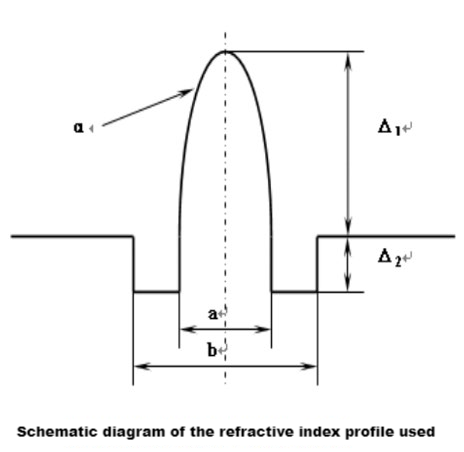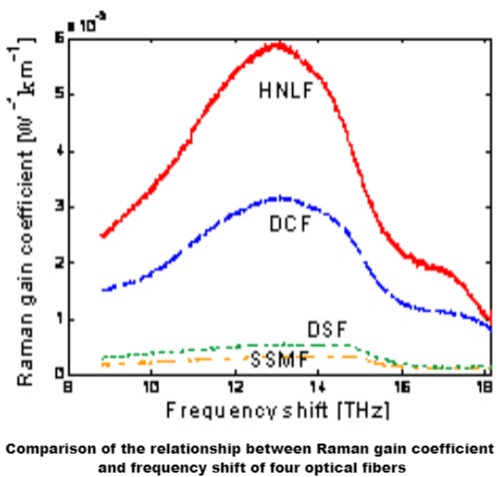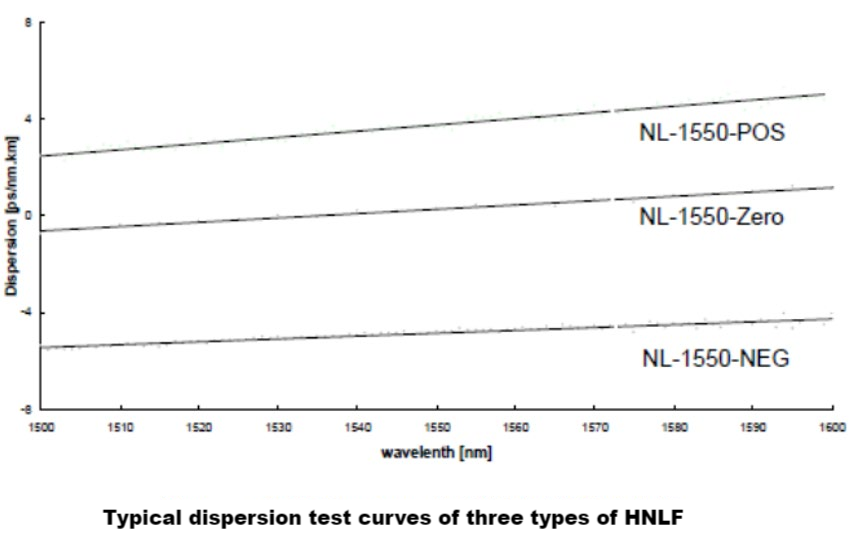- Cart
- |
- Personal Center
- |

C-band high nonlinear optical fiber dispersion 0.0±1ps/(nm.km
Nonlinear effects in optical fibers, such as stimulated Raman scattering (SRS), stimulated Brillouin scattering (SBS), and the optical Kerr effect, have many applications in the fields of communications and optical signal processing. In the Kerr effect, the refractive index of the light-guiding medium changes with the optical power, which will lead to a series of secondary effects, such as self-phase modulation (SPM), cross-phase modulation (XPM), four-wave mixing (FWM), and non-steady-state modulation. Applications that utilize the Kerr effect include optical parametric amplification, frequency conversion, phase coupling, pulse compression and generation, and optical soliton transmission. The design of highly nonlinear optical fibers needs to consider the following aspects: first, the optical fiber must have high nonlinearity to obtain effective nonlinear interactions; second, the optical fiber must have low loss to increase the effective action length Leff. Third, for various applications, the optical fiber must have matching dispersion characteristics. Finally, the nonlinear optical fiber must have low polarization mode dispersion (PMD). For silica-based highly nonlinear optical fibers, the design of the refractive index profile plays an important role in meeting the above requirements. In the design of high nonlinear optical fiber, a small core effective area Aeff, a low dispersion slope and a cutoff wavelength much smaller than the working wavelength must be achieved at the same time. High nonlinear optical fiber not only has high nonlinearity, but also has a very low dispersion slope. A flexible W-shaped profile design is adopted to introduce a low refractive index inner cladding around the step refractive index core.
Product features:Higher nonlinear coefficient、 Zero dispersion wavelength is adjustable in three bands: S, C, and L、 Lower loss and low dispersion slope、 Small additional loss when spliced with ordinary single-mode fiber
Part Number:--
Application area:Parametric amplification、 Wavelength conversion、 Pulse compression、 Supercontinuum source、 Optical regenerator、 Discrete (or lumped) Raman amplifier
Add to Cart Consult Favorite
Photoelectric parameters:
Fiber Type | NL-1550-POS | NL-1550-ZERO | NL-1550-NEG |
Optical properties | |||
Operating band | C-band | ||
Dispersion slope @1550nm (ps/nm2/km) | <0.035 | <0.030 | <0.030 |
Dispersion @1550nm (ps/nm/km) | >1 | 0.0±1 | <-1 |
Non-linear coefficient @1550nm (W-1km-1) | ≥10 | ||
Attenuation coefficient @1550nm (dB/km) | ≤1.5 | ||
Cut-off wavelength (nm) | <1480 | ||
Numerical aperture (typical value) | 0.35 | ||
Geometric properties | |||
Glass cladding diameter (μm) | 125±7 | ||
Cladding non-circularity (%) | ≤1 | ||
Core cladding concentricity (μm) | ≤0.5 | ||
Coating diameter (μm) | 245±10 | ||
Note:
* Provides support for fiber splicing.
* The fluctuation range of the glass cladding diameter of a specific optical fiber is no more than 2um.



Characteristics | Conditions | Data | Unit |
Geometric properties | |||
Core diameter | -- | 62.5±2.5 | [μm] |
Core non-circularity | -- | ≤5.0 | [%] |
Cladding diameter | -- | 125.0±1.0 | [μm] |
Cladding non-circularity | -- | ≤1.0 | [%] |
Coating diameter | -- | 245±7 | [μm] |
Coating/cladding concentricity | -- | ≤10.0 | [μm] |
Coating non-circularity | -- | ≤6.0 | [%] |
Core/cladding concentricity | -- | ≤1.5 | [μm] |
Fiber length | -- | Longest to17.6 | [km/coil] |
Optical properties | |||
Attenuation | 850nm | ≤2.7 | [dB/km] |
1300nm | ≤0.6 | [dB/km] | |
Full injection bandwidth | 850nm | ≥200 | [MHz·km] |
1300nm | ≥500 | [MHz·km] | |
Numerical aperture | -- | 0.275±0.015 | -- |
Group refractive index | 850nm | 1.496 | -- |
1300nm | 1.491 | -- | |
Zero dispersion wavelength | -- | 1320~1365 | [nm] |
Zero dispersion slope | 1320nm≤ λ0 ≤1348nm | ≤0.11 | [ps/(nm2·km)] |
1348nm≤ λ0 ≤1365nm | ≤0.001(1458-λ0 ) | [ps/(nm2·km)] | |
Macrobending loss | -- | -- | -- |
100 turns, radius 37.5mm | 850nm | ≤0.50 | [dB] |
1300nm | ≤0.50 | [dB] | |
Backscattering characteristics 1300nm | |||
Steps (average of bidirectional measurements) | -- | ≤0.10 | [dB] |
Irregularities and point discontinuities in the length direction | -- | ≤0.10 | [dB] |
Attenuation non-uniformity | -- | ≤0.10 | [dB/km] |
Environmental Characteristics 850nm and 1300nm | |||
Temperature cycle additional attenuation | -60℃ to 85℃ | ≤0.10 | [dB/km] |
Temperature-humidity cycle additional attenuation | -10℃ to 85℃,4% to 98% relative humidity | ≤0.10 | [dB/km] |
Water immersion additional attenuation | 23℃, 30 days | ≤0.10 | [dB/km] |
Dry heat additional attenuation | 85℃, 30days | ≤0.10 | [dB/km] |
Additional damp heat attenuation | 85℃ and 85%Relative humidity,30days | ≤0.10 | [dB/km] |
--
⇪